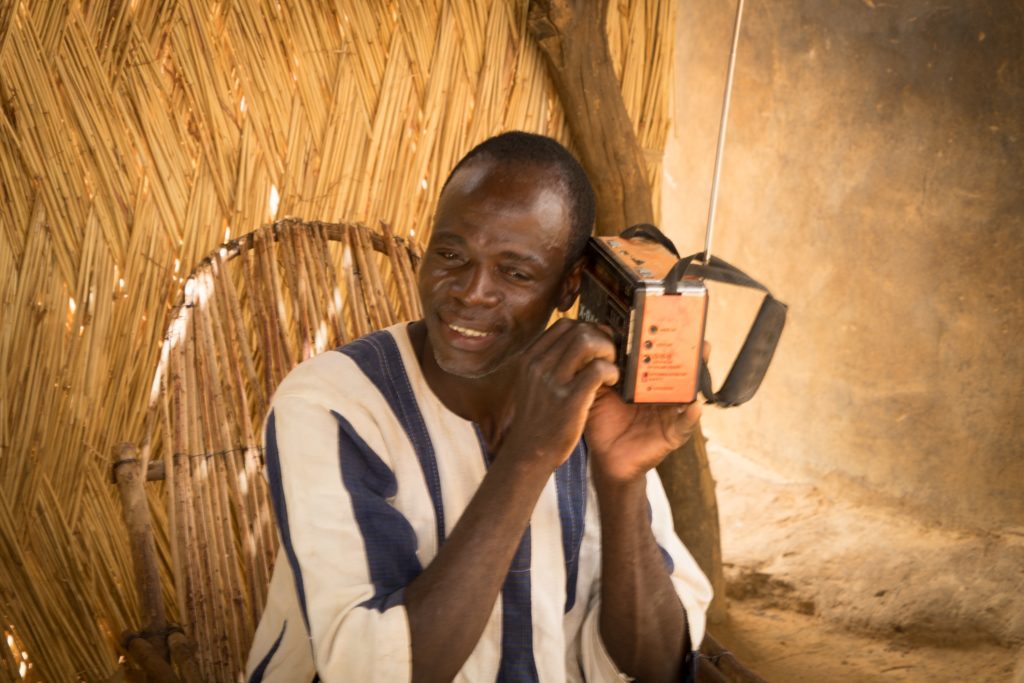Radha Chakraborty (Creative Director, Development Media International)
When Mariéta was only a year old she fell ill after sleeping outside. Her father Tibandiba thought she had been cursed because a bird had flown over her while she slept – a widely held belief in rural Burkina Faso. He paid the little money he had to traditional witch doctors, but none of their remedies worked. With Tibandiba not knowing where else to turn, Mariéta grew increasingly ill and slipped into a coma.
Fortunately, one day Tibandiba overheard one of Development Media International’s (DMI) radio messages describing the symptoms of malaria in children and the need to quickly seek medical treatment. He took Mariéta straight to the local health centre, where she received the treatment she needed and made a full recovery. Now, the village calls her ‘the child of the radio’. Tibandiba tells us he still carries his portable radio with him wherever he goes.

Mariéta’s story is compelling. And the international development world is full of stories like hers, where tangible and immediate impact demonstrate the huge value that investments in development bring. But these stories are not enough. Donors need more than anecdotes to help them to decide where to invest – and we owe it to those allocating the funds to have robust scientific proof that our interventions work. This is particularly true in my field of health communications, where, despite millions being spent, no one has ever proved that mass media can change health-seeking behaviours.
Well – not until now. Today, DMI and the London School of Hygiene & Tropical Medicine (LSHTM) are publishing the results of a randomised controlled trial we ran in Burkina Faso that shows extraordinary results from the radio campaign that Tibandiba heard. Data from over half a million consultations showed that treatment-seeking for sick children increased dramatically in our intervention zones compared to our control zones (where we didn’t broadcast). As a result of this increased treatment-seeking, malaria diagnoses in our intervention zones increased by 56% relative to control zones in the first year of the campaign. Pneumonia diagnoses over the same period went up by 39% and diarrhoea diagnoses by 73%.
Pneumonia, malaria, and diarrhoea are three of the biggest killers of children in Sub-Saharan Africa. So, using the Lives Saved Tool, we modelled the impact of these increases on child mortality in our intervention zones. The result: a 9.7% reduction in child deaths. For this radio campaign, that meant almost 3,000 child’s lives saved.
And how did the cost compare with other interventions? Our campaign only costs between $7 and $27 for each additional year of healthy life – which makes it one of the most cost-effective ways there is of saving a child’s life. This is the first time a rigorous scientific analysis like this has successfully been carried out on the effects of mass media on behaviours.
We are delighted by these results – and are committed to bringing scientific rigour to our campaigns as we undertake our next randomised controlled trial on the effect of mass media campaigns on sexual and reproductive health.
This project was funded by the Wellcome Trust and the Planet Wheeler Foundation.
Watch an animation about this research here.
The small-print:
Results from the first randomised controlled trial to show that mass media can significantly change health-seeking behaviours have been published today in BMJ Global Health. The study shows that a mass radio campaign in rural Burkina Faso resulted in a significant rise in families of young children seeking medical attention and in diagnoses and treatment of deadly illness. An accompanying article shows that it could be one of the most cost-effective ways to save children’s lives in low-income countries. The campaign promoted treatment-seeking for three of the biggest killers of children under five: malaria, pneumonia and diarrhoea.
Image credit: Richard Horvath via Unsplash
